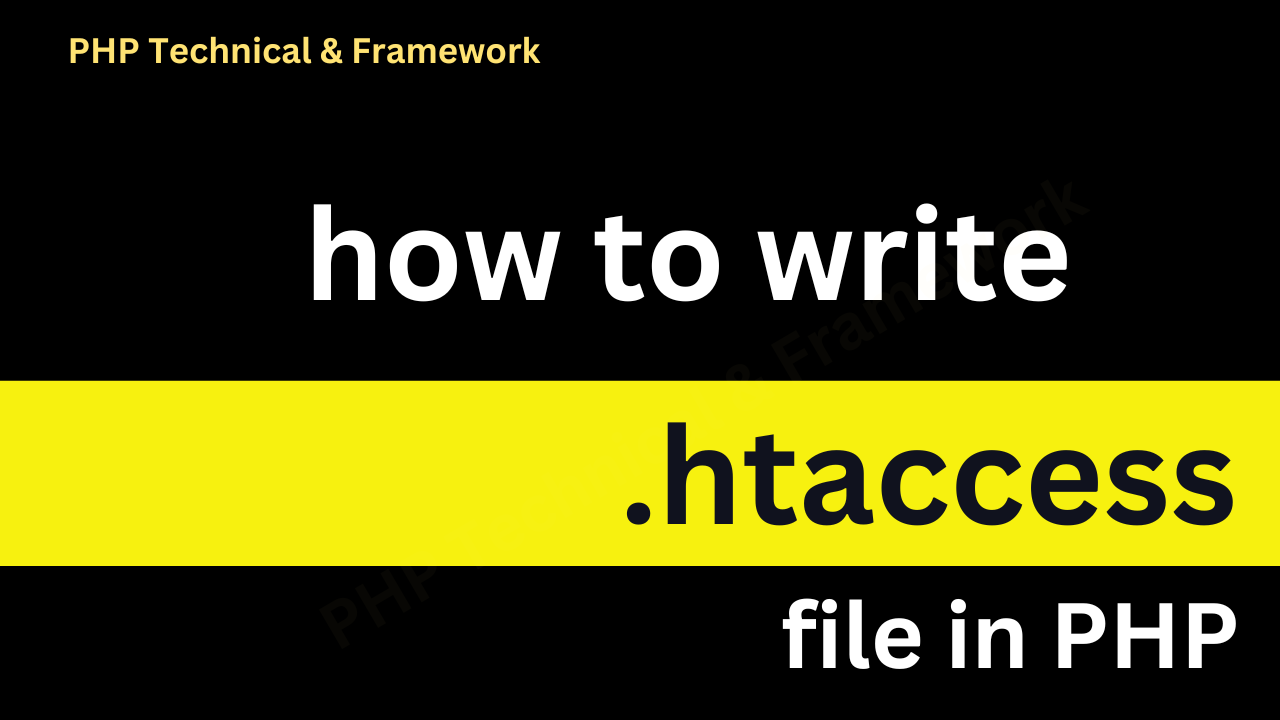how to write .htaccess file in PHP
How to write .htaccess file in PHP: In the dynamic world of web development, creating a seamless user experience and ensuring optimal website performance are paramount. One tool that plays a crucial role in achieving these goals is the .htaccess file. This blog post will provide you with a step-by-step guide on how to write .htaccess files in PHP, helping you enhance your website’s functionality, security, and SEO-friendliness.
Understanding the .htaccess File: The .htaccess file is a configuration file used on web servers, particularly Apache, to modify the server’s behavior for specific directories. It’s a powerful tool that enables developers to control various aspects of their website, such as URL rewriting, access control, security settings, and more. Writing a .htaccess file in PHP allows you to harness the server’s capabilities dynamically.
how to write .htaccess file in PHP
Creating a Basic .htaccess File: To get started, open a text editor and create a new file named .htaccess. Ensure that your file’s name starts with a period, as this is essential for it to work correctly. Here’s a basic example of a .htaccess file written in PHP:
<?php
// PHP code here
?>
# Apache configuration directives here
Common Use Cases:
- URL Rewriting:
One of the most common uses of .htaccess files is URL rewriting, which helps create user-friendly and SEO-optimized URLs. For instance, you can convert:
phpfortech.com/product.php?id=123
into:
phpfortech.com/products/123To achieve this, use the mod_rewrite module and the RewriteRule directive within your .htaccess file.
RewriteEngine On
RewriteRule ^products/([0-9]+)/?$ product.php?id=$1 [L]
- Enabling Compression:
Compression significantly improves website loading speed. You can enable GZIP compression using the following code in your .htaccess file:
<IfModule mod_deflate.c>
AddOutputFilterByType DEFLATE text/html text/css text/plain text/xml application/javascript application/x-javascript application/rss+xml application/xml
</IfModule>
- Redirects:
Permanent (301) and temporary (302) redirects can be crucial for maintaining SEO value and ensuring a smooth user experience when pages are moved or removed.
# Permanent Redirect
Redirect 301 /old-page.php /new-page.php
# Temporary Redirect
Redirect 302 /maintenance.html /under-construction.html
- Enforcing HTTPS and Non-www Redirect:
Security is a top priority for any website. Enforcing HTTPS and redirecting non-www URLs can help you achieve a more secure environment and ensure consistent URLs. Add the following code snippet to your .htaccess file:
RewriteEngine On
RewriteCond %{HTTPS} off [OR]
RewriteCond %{HTTP_HOST} !^www\. [NC]
RewriteRule ^(.*)$ https://www.phpfortech.com/$1 [L,R=301]
This code snippet checks if HTTPS is off or if the URL doesn’t start with “www.”. If either condition is met, it redirects to the secure and www-prepended version of your website.
Clean URL Rewriting with Extension Removal:
Clean URLs not only improve user experience but also have SEO benefits. This code snippet removes file extensions like .php from URLs and allows you to access pages without the extension:
Options +MultiViews
RewriteEngine On
RewriteCond %{REQUEST_FILENAME} !-d
RewriteCond %{REQUEST_FILENAME} !-f
RewriteRule ^([^\.]+)$ $1.php [NC,L]
By adding this code, you can access a page like picposter.live/about instead of picposter.live/about.php.
- Custom 404 Error Page:
Providing a user-friendly and informative 404 error page is essential to guide users when they encounter broken links or non-existent pages. Here’s how you can set up a custom 404 error page:
ErrorDocument 404 https://phpfortech.com/404
This code directs users to your custom 404 error page when a page is not found, enhancing their experience and keeping them engaged with your website.
Putting It All Together:
By integrating these advanced code snippets into your .htaccess file, you’ve taken significant steps toward creating a more secure, SEO-friendly, and user-centric website. From enforcing HTTPS and clean URL rewriting to providing a custom 404 error page, your website’s performance and user experience will undoubtedly improve.
Full Code:
RewriteEngine On
RewriteCond %{HTTPS} off
RewriteRule ^(.*)$ https://%{HTTP_HOST}%{REQUEST_URL} [L,R=301]
Options +MultiViews
RewriteEngine On
RewriteCond %{REQUEST_FILENAME} !-d
RewriteCond %{REQUEST_FILENAME} !-REQUEST_FILENAME
RewriteRule ^([^\.]+)$ $1.php [NC,L]
#404 page
ErrorDocument 404 https://phpfortech.com/404Conclusion:
In this comprehensive guide, we’ve delved into the world of .htaccess files in PHP, from the basics to advanced configurations. By mastering the art of writing these files, you can optimize your website’s security, performance, and SEO-friendliness. Whether you’re redirecting URLs, enabling HTTPS, or crafting custom error pages, .htaccess files empower you to take control of your website’s behavior. So, implement these code snippets, experiment, and watch your website thrive in the dynamic landscape of web development.
Keyword:
PHP | HTAccess | Web Development | Server Optimization | Tech Tutorial | php technical framework | php for tech | php for beginner | php for beginners | pic poster | debjit das | sticky bookmark | code banda
